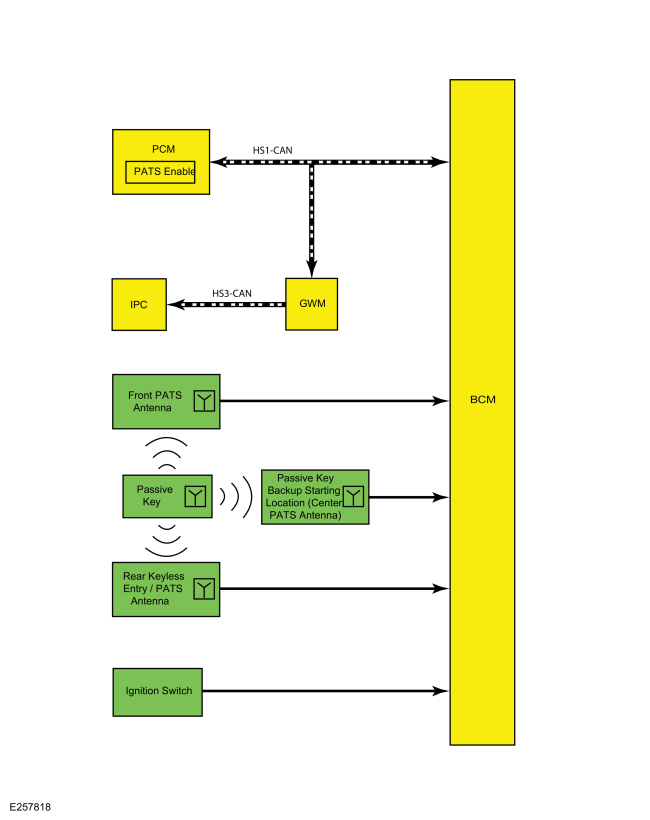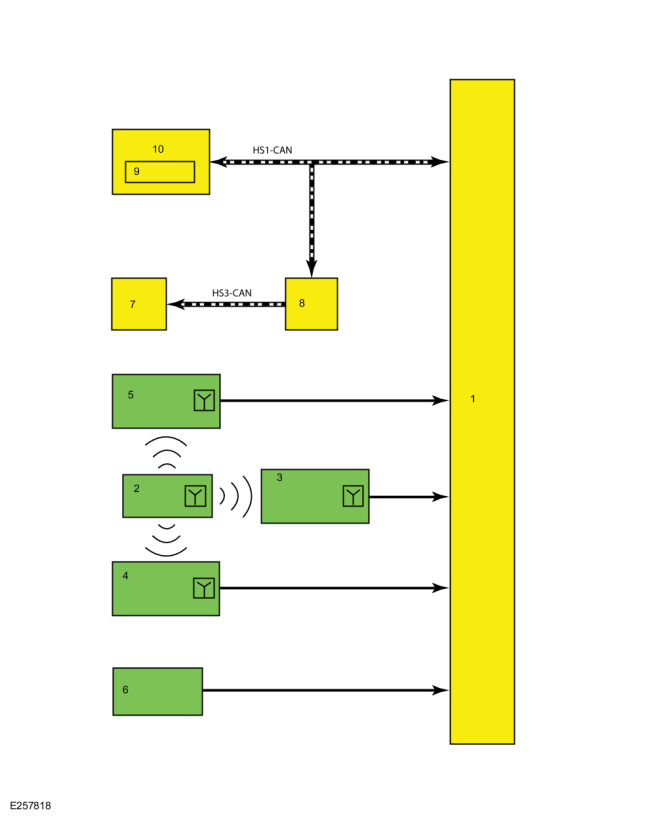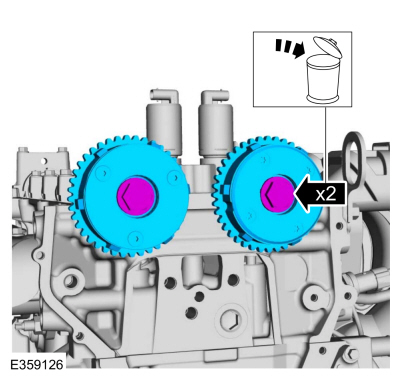Ford Ecosport: Passive Anti-Theft System (PATS) - Vehicles With: Keyless Entry and Push Button Start / Description and Operation - Passive Anti-Theft System (PATS) - System Operation and Component Description
System Operation
System Diagram

| Item | Description |
|---|---|
| 1 | BCM |
| 2 | Passive Key |
| 3 | PATS Center Antenna |
| 4 | Keyless Entry Rear Antenna |
| 5 | PATS Front Antenna |
| 6 | Ignition Switch |
| 7 | IPC |
| 8 | GWM |
| 9 | PATS Enable |
| 10 | PCM |
Network Message Chart
Module Network Input Messages - BCM
| Broadcast Message | Originating Module | Message Purpose |
|---|---|---|
| PATS start request target data | PCM | The PCM sends the BCM a challenge request for a valid ID. |
Module Network Input Messages - IPC
| Broadcast Message | Originating Module | Message Purpose |
|---|---|---|
| Ignition status | BCM | Used by the IPC to power up when the START/STOP button is pressed and a programmed key is detected within the vehicle or to power down when the request is to turn the vehicle off. |
| Vehicle mode | BCM | Used by the IPC to display “No Key Detected” when the START/STOP button is pressed and no programmed key is detected within the vehicle. |
Module Network Input Messages - PCM
| Broadcast Message | Originating Module | Message Purpose |
|---|---|---|
| PATS control command | BCM | The response from the BCM supplying the PCM challenge ID. If the BCM ID response is incorrect, then PATS prevents the vehicle from starting. |
PATS
The PATS function is controlled by the BCM and the PCM .
When the START/STOP button is pressed, a voltage signal is sent to the BCM . When the BCM detects the START/STOP button is pressed, it begins the key initialization sequence by activating the PATS center antenna, PATS front antenna, and keyless entry rear antenna. Each antenna transmits a low frequency signal with an approximate range of 1m (3ft). The passive key activates if it is within range of the antennas. The BCM is able to determine the passive key location (inside or outside the vehicle) based on the input from the antennas.
When the passive key activates, it sends the PATS identification code to the BCM via a high frequency signal. The BCM interprets the high frequency signal from the passive key.
If a programmed passive key is detected inside the vehicle, the BCM transitions the ignition from OFF to ON.
When the ignition transitions from OFF to ON and the modules initialize, the PCM sends a challenge request to the BCM . The BCM replies and if the correct identification is received, the PATS disables and allows the vehicle to start. If the PATS prevents the vehicle from starting, a DTC sets in one of the modules.
The PATS and the RKE system share operation of several components including the passive keys and BCM .
If there is a concern with either of these components, the PATS and the RKE system are both affected.
In the event of a no start, place a programmed passive key in the backup location to allow the vehicle to start. The PATS center antenna activates the passive key when the START/STOP button is pressed in the event the batteries are depleted within the passive key.
If available as a selection on the diagnostic scan tool, the passive start feature is a programmable parameter and can be enabled/disabled. If the feature is disabled, the features to passively enter and start the vehicle are inoperative. To start the vehicle, the passive key must be placed in the backup starting location.
The BCM controls the ignition modes and, in conjunction with the PCM , controls the PATS .
PATS Parameter Identifications (PIDs)
In conjunction with Diagnostic Trouble Codes (DTCs), the PATS Parameter Identifications (PIDs) are a useful tool when diagnosing PATS concerns.
BCM PID Chart
| Broadcast Message | Originating Module | Message Purpose |
|---|---|---|
| KEYS_PROGMD | PATS number of ignition key codes supported | Displays the number of keys currently programmed into the BCM . If unlimited key mode is enabled, this PID only reads 2 regardless of how many keys are programmed. |
| MIN_KEYS_RQD | Minimum number of keys required | Minimum number of programmed keys required. This PID always reads 2. |
PCM PID Chart
| Broadcast Message | Originating Module | Message Purpose |
|---|---|---|
| PATSENABL | Vehicle enable status | Indicates if PATS allows the vehicle to be driven. Must read enabled for the vehicle to be driven. |
Component Description
BCM
If the BCM is replaced, program at least 2 keys and perform the parameter reset procedure.
The BCM requires PMI when it is replaced.
Keyless Entry Rear Antenna
NOTE: Some brands/types of mobile phone or laptop computer chargers may cause interference that could lead to a PATS concern if the passive key is within a few inches of the charger and the “No Key Detected” message displays in the message center. If a concern is observed, move the passive key away from the charger and attempt to transition the ignition on.
The keyless entry rear antenna is wired to the BCM . When activated by the BCM , it transmits a low frequency signal that activates a passive key.
A programmed passive key must be within the passenger compartment or cargo area for the PATS to detect the passive key and allow the ignition to transition from OFF to ON.
If a passive key is placed in the far outside edges of the interior, such as the far corners of the passenger compartment or cargo area, the vehicle can experience a PATS concern. If the passive key is located in one of these areas and there is a PATS concern, move the passive key out of the area and attempt to transition the ignition on. If the key is outside the range of the keyless entry rear antenna, PATS center antenna, and PATS front antenna when the START/STOP button is pressed, the No Key Detected message displays in the IPC message center.
Passive Key
NOTE: Some brands/types of mobile phone or laptop computer chargers may cause interference that could lead to a PATS concern if the passive key is within close proximity of the charger. If a concern is observed, move the passive key away from the charger and attempt to turn the ignition on.
The passive key incorporates both the PATS and the RKE transmitter functions in a single device. The passive key must be located inside the vehicle for the ignition to transition from OFF to ON and on the outside for keyless entry features. During key programming procedures, the PATS and the RKE transmitter of the passive key are both programmed into the BCM . The vehicle accepts programming of up to 4 passive keys.
The passive key receives the low frequency signals from the PATS center antenna, PATS front antenna, and keyless entry rear antenna. When the passive key is activated by one of the low frequency signals, it sends out a high frequency signal that is received by the BCM . The passive key must be located inside the vehicle for the ignition to transition from OFF to ON and outside the vehicle for passive entry features.
The passive key also contains a removable key blade that unlocks the driver door in the event of an electrical failure (such as a drained battery).
The passive key requires 1 battery. For battery replacement instructions, refer to the Owner's Manual.
For backup starting, refer to "Backup Starting" in this section.
PATS Center Antenna
NOTE: Some brands/types of mobile phone or laptop computer chargers may cause interference that could lead to a PATS concern if the passive key is within a few inches of the charger and the No Key Detected message displays in the message center. If a concern is observed, move the passive key away from the charger and attempt to transition the ignition on.
The PATS center antenna is wired to the BCM . When activated by the BCM , it transmits a low frequency signal that activates a passive key. This antenna serves a dual purpose in that it can detect a passive key in the backup starting location. The backup starting location is used to program passive keys and to detect a programmed passive key in the event the battery in the programmed passive key has failed.
A programmed passive key must be within the passenger compartment or cargo area for the PATS to detect the passive key and allow the ignition to transition from OFF to ON.
If a passive key is placed in the far outside edges of the interior, such as above a sun visor or in a door map pocket, the vehicle can experience a PATS concern. If the passive key is located in one of these areas and there is a PATS concern, move the passive key out of the area and attempt to transition the ignition on. If the key is outside the range of the keyless entry rear antenna, PATS center antenna, and PATS front antenna when the START/STOP button is pressed, the No Key Detected message displays in the IPC message center.
PATS Front Antenna
NOTE: Some brands/types of mobile phone or laptop computer chargers may cause interference that could lead to a PATS concern if the passive key is within a few inches of the charger and the No Key Detected message displays in the message center. If a concern is observed, move the passive key away from the charger and attempt to transition the ignition on.
The PATS front antenna is wired to the BCM . When activated by the BCM , it transmits a low frequency signal that activates a passive key.
A programmed passive key must be within the passenger compartment or cargo area for the PATS to detect the passive key and allow the ignition to transition from OFF to ON.
If a passive key is placed in the far outside edges of the interior, such as above a sun visor or in a door map pocket, the vehicle can experience a PATS concern. If the passive key is located in one of these areas and there is a PATS concern, move the passive key out of the area and attempt to transition the ignition on. If the key is outside the range of the keyless entry rear antenna, PATS center antenna, and PATS front antenna when the START/STOP button is pressed, the No Key Detected message displays in the IPC message center.
PCM
When the PCM is replaced, perform the parameter reset procedure. There is no need to program keys if the PCM is replaced.
The PCM requires PMI when it is replaced.
 Description and Operation - Passive Anti-Theft System (PATS) - Overview
Description and Operation - Passive Anti-Theft System (PATS) - Overview
Overview
PATS uses the following main components:
BCM
PATS center antenna
PATS front antenna
Passive key
PCM
Keyless entry rear antenna
Start/Stop Switch
When the START/STOP button is pressed, the key data is read by a
PATS antenna...
 Diagnosis and Testing - Passive Anti-Theft System (PATS)
Diagnosis and Testing - Passive Anti-Theft System (PATS)
DTC Chart: BCM
Diagnostics in this manual assume a certain skill level and knowledge of Ford-specific diagnostic practices. REFER to: Diagnostic Methods (100-00 General Information, Description and Operation)...
Other information:
Ford Ecosport 2014-2025 Service and Repair Manual: Removal and Installation - Rear Window Wiper Motor
Removal NOTE: Removal steps in this procedure may contain installation details. Remove the rear window wiper pivot arm. Refer to: Rear Window Wiper Pivot Arm (501-16 Wipers and Washers, Removal and Installation). Remove the liftgate trim panel...
Ford Ecosport 2014-2025 Service and Repair Manual: Removal and Installation - Parking Brake Front Cable
Removal NOTE: Removal steps in this procedure may contain installation details. NOTE: Left hand drive (LHD) shown, right hand drive (RHD) similar. Remove the parking brake control. Refer to: Parking Brake Control (206-05 Parking Brake and Actuation, Removal and Installation)...


